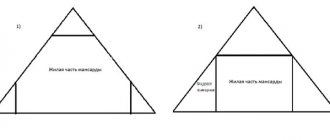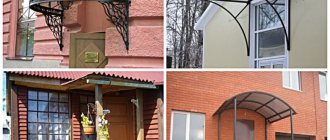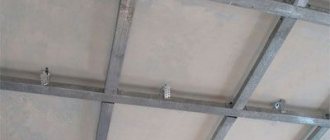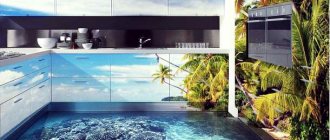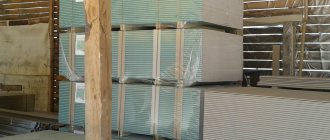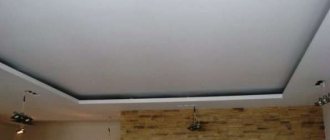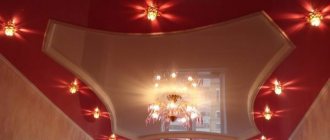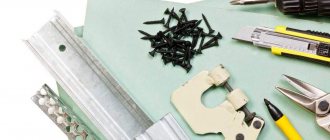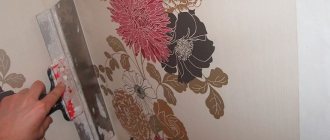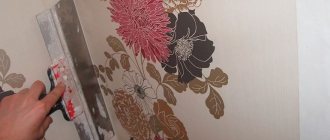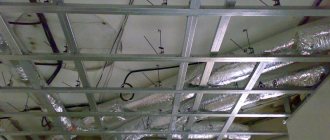The use of a design such as a false window can change the existing interior of any room beyond recognition. By creating a false window with your own hands, you can easily hide any imperfections in the surface, and at the same time convey the much-needed atmosphere of comfort and coziness into the room, allowing you to turn even the most daring design solutions into reality.
- Upcoming manipulations
Any person strives to create comfort in his home, while trying to reduce the necessary costs to a minimum. With the use of a variety of modern design solutions, this has become not only possible, but also accessible to everyone. One of the excellent solutions that allows you to create much-needed comfort in a room for any purpose is to create a false window with your own hands.
Original use of simple false windows
The layout of the house does not always allow for a decent view from your own window. In order to adjust the basic characteristics of the room, it is recommended to use a false window design, which can be equipped with its own lighting. It is almost impossible to purchase a ready-made product, and the cost of such an order from a specialist can cost $25-150. However, there is still a solution. So, you can make a false window with your own hands.
Types of false windows
Today it is becoming possible to use several types of false windows simultaneously, which will differ from each other:
- the complexity of installation work;
- type and shape of the chosen design.
Most often you can find these types of decor for false structures in the form of:
- curtains with curtains;
- window sills.
Based on the design features, the following types of false windows are distinguished:
| Short description | Photo |
| In the form of a landscape on the wall | |
| Mirror false window | |
| False window located on the ceiling | |
| Stained glass false windows |
Still have questions? Call!
We use an individual approach to each client. At a time convenient for you, our competent manager will contact you for advice or assistance in choosing components for your order.
A professional designer, together with you, will select for free which option to buy false windows would be more appropriate, so that it meets your wishes and the characteristics of the room (moisture protection, compliance with the overall style of the interior). All work is guaranteed. On the day you contact us, you will know the cost of the order, which consists of the size, complexity of the work, the presence of a window sill and slopes, and the cost of materials.
When is it better to use false windows?
- False windows will look quite interesting and at the same time unusual in the corners and dark corridors of the house.
- False windows are extremely often used in small rooms, where a perspective image will help visually increase the much-needed space. Photographic images may also be used.
False window in the bathroom
- Work areas, which include nooks and crannies of the house, offices, libraries and other small rooms in which a sufficient amount of natural light is rare. By choosing a backlit window design, you can solve several problems at the same time and give the drawn space realism.
- There is often a small partition between the windows, which is rarely used. It is this space that can most easily be used to arrange a false window.
Application in the interior
Every person wants to see beautiful landscapes from their windows in the morning. But not everyone has such an opportunity. Most city apartment windows overlook other buildings or city roads. You can transform the interior of a room with the help of a false structure, which will open up to sea beaches, picturesque valleys, and flower fields.
Modern designers are able to realize any wishes of clients. They intelligently expand the space of the rooms, making blank walls look into another world.
Thanks to the variety of materials when creating false windows, structures of any shape and size can be made. The use of 3D technologies makes it possible to create realistic pictures that change the perception of housing.
Interior decoration using window imitation
Most creative people use false structures in their homes to lift their spirits in the morning and as decoration. The advantages of installing them include the ability to:
- admire the beautiful view from your room;
- visually enlarge the space and bring maximum light into it;
- highlight the interior of the house, make it original and as comfortable as possible for living.
With the help of false window openings, you can conveniently use non-functional niches, corners, and problem areas in the house. By decorating the imitation with curtains, you will make it more realistic.
Hiding design flaws
In addition to decorative functions, false windows will help hide minor wall defects and mistakes made in construction. Sometimes situations develop in such a way that you simply cannot do without them. This happens if:
- The space between the windows is inappropriate and non-functional. In this case, mirror false structures are used;
- The room (library, study) is located in a bad place and in a dark corner of the apartment. The false structure will fill the room with additional light;
- small room. It is important to use photographic images here;
- The corridor is too dark, some light needs to be brought in.
Do-it-yourself false window with backlight: step-by-step instructions
Tools you will need:
- A large sheet of plywood, the dimensions of which must match and even exceed the dimensions of the future false window.
- Leatherette or any other material that will be used for covering, foil.
- When making a false window with backlight, you will need several LED strips. Complex soldering should be avoided, and sales assistants and store consultants will help with the rest.
- A decorative frame that will frame the future window.
- Stationery knife with an oblique blade.
- Polyurethane foam and good glue.
- Glass (panel) or colorless plastic, which is considered the more preferable material. Its thickness should be 2 mm or less. A drawing that is ideal in size and for the chosen topic. You can use small photo wallpapers.
It is worth noting that there is no need to use expensive materials, and all work can be done independently if you have free time and basic skills in handling available devices and tools. A set of different screwdrivers will not be superfluous. You should also make sure you have screws, a drill, sandpaper, construction (painting) tape and a hammer.
Making a box
When using a panel made of glass, it must be cut right in the store, since it is extremely difficult to do this yourself. The use of a glass panel requires the manufacture of a wooden frame. It is recommended to use a sealant to install the glass into the frame. This process is considered more labor-intensive compared to the same plastic element, which can be purchased at any hardware store for a low cost.
Examples of boxes for false windows
When using plastic, its surface can be either transparent or matte, which will help achieve the effect of diffused lighting, but it is not recommended to remove the protective film. This type of material has an extremely fragile surface, which is very easy to leave deep scratches on. It is from plastic that templates for the future window will be made.
Multi-colored glass for false windows
As a result, you should get ten blanks. However, each part must first be cut out of durable cardboard, which will make transferring to plastic easier and less labor-intensive.
- The picture will be glued to the front part of the box, so its dimensions must fully correspond to the size of the picture itself. In order for the painting to be slightly bent on all sides, it is necessary to remove the extra 2 cm. Measurements must be taken carefully.
Measuring the location of the image on the frame of the false window - The height of the box for making the roof should be about 8-12 cm, everything will depend on the width of the selected LED strip, if one is used. The dimensions of the transformer and other key elements are also taken into account.
Location of the LED strip in the false window box - The bottom of the box itself is also made according to the dimensions of the front side of the box. Only 0.5 cm is taken away from each side so that it is possible to close the box after inserting the structure inside.
- For the bottom you will need to make four more walls. Their dimensions will completely coincide with those used in the manufacture of the lid.
The process of making profiles for a false window
Then you should begin gluing the entire structure. When working with plastic elements, dichloroethane is often used, which belongs to the category of extremely caustic substances. In addition to the fact that the substance is extremely dangerous, it can also ignite. It is not recommended for use at home, and it does not provide the much-desired indicator of hardness. For domestic purposes, titanium is better suited, which can also be used when working with structures consisting of PVC elements.
Glue "Titan"
Pieces of plastic corner are glued to the corners so that they hold more firmly. The cost of such material is small, and you can find it in any construction market. Otherwise, it will be necessary to drill holes and install the structure on bolts, which will affect the appearance of the product.
Further stages of working with the box
After the box has been completely assembled, you should begin manipulations that will be aimed at transforming and decorating such an unusual decorative element as a false window. All angles of the structure must be 90°, otherwise the frame will turn out crooked, and this will be visible at first glance. In addition, it will not be possible to assemble everything as needed with crooked corners.
Always double check the evenness of the frame corners
Sequencing:
- The bottom of the assembled box is covered with foil. This is done to ensure that the lighting effect is maximum. Instead, you can use mirror plates, then there is no need to use foil. The cost of such material is somewhat more expensive. But the material that is available in the kitchen of every housewife without exception is perfect for foil.
- LED strips should be used at low power, but the placement of the bulbs should be as frequent as possible. This way the light will be distributed evenly and naturally. A roll of such material contains 5 m of tape with diodes, and five such coils should be purchased.
- You will need a transformer with a power of 450-600 watts.
Transformer for LED strip - The tape is cut along the length of the box in small sections, the length of which will be about 1.3 m. The quantitative sequence of such connections will be only three sections, otherwise the transformer will not cope. All other strips will be attached in parallel. The strips are attached to the reflective foil, connected to the transformer and brought to the outlet using ordinary copper wires.
An example of the arrangement of LED strips on a false window. It’s wise to make them in smaller quantities - it won’t make things worse - A pre-selected image is attached to the lid of the box. However, there are still some nuances. Strips of glue applied to the surface of the structure may be visible, so it is applied only to areas where bending over the edges of the frame occurs.
- On the sides, along their entire perimeter, the selected material (leatherette, for example) is pasted over, which will make the appearance of the structure more aesthetic.
Afterwards the two parts of the frame are assembled together. It is worth paying attention to the fact that the further the lid is placed from the bottom, the weaker the picture will be illuminated. A small niche is made on the surface of the wall, which should be slightly larger than the prepared canvas, where it will be placed. The wires are connected to the switch. The structure is inserted into the opening, a window or picture frame is installed on top of it, the surface of which is treated with any available material (leather, faux leather, fabric).
The process of making a false window with lighting yourself
You can also watch a video with a step-by-step and simple process of making an interesting false window with backlight:
Transforming your apartment space
The layout of apartments or private houses often does not suit us, this is an indisputable fact. As a result, finishing using false systems can be a unique way to transform a place, add comfort to a room, or even completely transform empty corners into a study, library or a comfortable area for rest and relaxation.
A false window with beautiful lighting looks impressive and most advantageous. These are quite complex systems, however, not due to any industrial technologies, but because of the labor-intensive installation process, due to the large volumes of the upcoming illuminated picture.
Moreover, making a false window with lighting with your own hands is not at all difficult, as it seemed, but first you need to find out what advantages they can bring to your life. One thing is absolutely clear, similar concepts have almost no shortcomings, except that the window interferes with the placement of furniture. But in this case, you can simply remove the artificial window with imitation of natural light from the wall, and the problems will be behind you.
Everyone, most likely, wants a beautiful view from their window, for example, of the Alpine mountains, a dense forest or cool forest, a colorful metropolis, a calm courtyard or the sea coast. But the population of large settlements is often deprived of this opportunity, and only false windows can compensate for this deficiency and make the view from the window delightful.
Related article: Are brown plastic windows more expensive than white ones or not?
Such systems fit into almost any design and visually add space. If it is difficult to choose options for decorating a blank and bare wall, then directly simulating a backlit window in the interior can be this magic wand.
When figuring out how to make a false window on the wall, you need to understand that each reflective system will significantly visually enlarge the space, and a false window with illumination will make the room brighter.
A great solution would be a fake window with an image. It can be done in very small rooms, as well as living rooms, bathrooms and kitchens. Black corners will look much clearer and there will be much more space available. It is possible to make similar systems from completely different materials, for example, an old window frame, moldings, wood planks, just photo wallpaper, and even just paint it directly on the wall.
In order to fully understand how to make artificial windows in a wall with imitation of natural light, and then carry out all the work quickly and clearly, you will first have to prepare thoroughly. You will need to make your choice with the surface of the window, since it can simply be a drawing, or maybe a mirror; you need to prepare all the necessary tools, special equipment, and also the materials that will certainly be needed in the work.
A simpler option is to buy elegant photo wallpaper with a pattern of a colorful landscape, and then decorate it in the form of a light box, which is absolutely possible to do with your own hands and get an excellent result.
Imitating a window on the wall requires the following materials and tools:
- Photo wallpaper or image, suitable in scale, and also in theme. Here it is necessary to ensure that the image or photo wallpaper fits perfectly into any design and does not differ from it.
- You will need a glass panel for the window, but it is better to take transparent plastic, no more than 2 mm wide.
- High-quality super glue, for example “Titanium”, and also ordinary foam for installation.
- You will also need a utility knife with a sharp blade.
- Decorative frame for a window, you can take an old window frame, fastened moldings, or simply a frame for the canvas.
- LED strip, and also the cable and transformers for it.
- The foil will be the basis for the cladding.
Thus, in order to produce a high-quality imitation of a backlit window, you really won’t need to spend a lot of money.
However, you really need to work hard, you need to stock up on pliers and screwdrivers, any owner always has them at hand, in addition, you need to take a hammer, adhesive tape, a small piece of sandpaper, an electric drill and self-tapping screws.
Do-it-yourself false window from a mirror
Quite interesting solutions include the use of mirror surfaces in a room that falls into the small category. Thus, you can easily visually expand the boundaries of a small room. As a base you will need to use tiles or a full mirror. In fact, this will be an ordinary mirror built into the window frame.
Mirror false window
Installation is carried out on a flat surface, and there is no need to make any niches. However, the surface of the wall must be perfectly flat. Attaching a false window can be done in several ways.
In the first and, perhaps, the simplest case, the installation of individual elements of the structure itself is done - the glass is attached, and the frame is glued to it. To make the frame, a wooden board, plastic or any other material that could have been used to decorate the room earlier can be used.
DIY false window from a mirror. The wood is cut out and glued to the mirror base
In the second case, the already assembled and cut structure is fastened. To begin with, a frame with a lattice is attached, which will resemble a binding. Elements of tiles or mirrors of a certain size are cut out for existing niches, and then they are attached separately to each opening. Afterwards the structure is installed on the working surface.
DIY false window from a mirror. Mirrors are cut out separately and glued to the frame
There is no point in covering such false windows with curtains, since their main task will be to reflect the room, making it visually more spacious.
Complex projects
The implementation of the projects discussed below is fraught with certain difficulties. The design and installation are thought out at the interior planning stage - they choose the place where they will be installed, and arrange niches. The “windows” look like real ones. But to remove them will require major repairs.
False window in a suspended ceiling
Due to the inter-ceiling space that remains after stretching the canvas, you can make very impressive compositions. The design can be different - in a frame, in the form of a spaceship or submarine window, a transparent roof, etc.
The easiest way is to reproduce the window itself on canvas. Thanks to 3D photo printing, the drawings are quite realistic. Hidden lighting is installed between the base ceiling and the trim, adding volume and depth to the image. Another option is two-level structures. Photos are printed on the top film, and a frame-shaped frame is created on the bottom layer.
Double Vision technology allows you to apply a second image on the reverse side of the canvas, which will appear when the backlight is turned on. For example, during the day when the lights are off there will be a sunny blue sky, and in the evening there will be a reddish sunset.
With the help of stretch ceilings, a “starry sky” is often simulated. To do this, an optical fiber is passed through the canvas with a night landscape or pins are attached, recreating a semblance of the twinkling of stars. This design is often chosen for the bedroom or living room.
Imitation of a plasterboard window
A niche is installed in the suspended ceiling, the top of which is covered with photo wallpaper or similar materials. An installation similar to a window frame is assembled from below. The use of plasterboard allows you to make niches with rounded corners and create windows of unusual shapes.
The effect is enhanced if an LED strip is attached around the perimeter of the image. Then the false window turns into a light source. If the niche is large, LEDs are mounted over the entire surface of the ceiling, otherwise there will be a dark area in the center.
You can also install a combined gypsum plasterboard ceiling with tension fabric. A plasterboard box is installed around the perimeter of the room, and in the middle a PVC film with a photo print of a landscape or night sky is stretched, behind which a hidden backlight is placed.
Expensive plexiglass structures
This is one of the premium options for skylights. They are also called acrylic, glass or translucent ceilings.
The design of such false windows resembles stained glass. Plexiglas panels are available in white, colored and transparent. The frame profile joins at right angles or creates fancy patterns of broken lines. LED lighting is installed on top behind the panels, turning the entire ceiling into one huge lamp for the hall, dining room or corridor.
Such a structure can be created using an Armstrong-type suspension system and placed in the cells of the frame of acrylic glass panels of the appropriate size. Another option is to mount a wooden sheathing, to which you then attach plexiglass using a beading method. In this case, any shapes are available, since there is no need to be tied to the square grid of the frame for suspended ceilings.
False window from a mirror
This is a very interesting technique, the main purpose of which is to make the room taller. Such structures are usually attached to a base plate without a niche. The frame is made of plastic or wood. For the base use mirror tiles or full mirrors.
The imitation of a window on the ceiling is assembled in one of two ways:
- Mirrors and parts imitating a frame are glued onto the panel, and then attached to the ceiling.
- First, glass elements are glued to the ceiling, and then a wooden frame is made and installation is carried out.
Mirror illusions are often installed in squat rooms. The reflection from above creates a feeling of open space - a cramped room visually expands.
False window on the ceiling
This element of modern decor belongs to the category of the most common, which is often used by famous designers. Not everyone is able to design such elements on their own. Mounting on the ceiling surface can be done in three ways. In the first case, the ceiling must be perfectly flat and its surface only needs to be painted. However, this design is equally easy to mount both on the wall and on the ceiling. Installation can also be carried out on the surface of plasterboard ceilings, and this option is the most common. If you arrange a special niche, then the false window can be recessed into it.
False window on the ceiling
You can place lighting on the side niches, which can also be placed directly on the ceiling. However, in this case you will need to cover it with a pattern.
False window with lighting on the ceiling
The cable supply should be done in advance, and the supply will be carried out along the side wall and the small holes located there. The box will consist of a metal profile. After all the manipulations with the false window, the ceiling should be covered with plasterboard, which will allow the level of the ceiling and the window to be leveled.
Virtual ready-made false windows
This new product appeared relatively recently and came to us from European designers. In such structures it is customary to install living canvases, which can be changed at will by the owner of the apartment.
They are based on the principle of using a liquid crystal display, which is connected to a special device. In this way, it is possible to convey a rich and juicy picture. With their help you can create the necessary comfort in any room.
With the help of realistic pictures, you can transform the room, bringing the much-desired sunny and warm weather closer to a gray and boring day. However, regardless of the location of the structure, its color must correspond to the general style of the room, and the connection of light must be carried out in full and strict compliance with all existing fire and other safety rules.
An example of how such windows work can be seen in the video below. Quite an interesting, but expensive spectacle.
Advantages
Many designers use imitation windows when decorating houses. This is not surprising, because such structures have practically no drawbacks, and the scope for the possibility of their installation and types and combinations is simply huge. In addition to the original interior design, false windows allow you to make them look at your discretion.
The products will fit ergonomically and correctly into any interior, making it brighter and visually enlarging the space. Do you want to watch the sea surf, a beautiful sunset or a frosty blizzard every day, as well as another landscape to choose from? If so, then the design in question is the best opportunity for this.
False window designs can turn the disadvantages of rooms into their advantages; a lot of materials can be used as materials for their manufacture. The size and shape are also selected according to individual preferences and do not have any restrictions. Variations of the 3D format, which are created using the most modern technologies and software, will help to radically transform the room.
Do-it-yourself false window with a wall. Photo instructions
This photo instruction shows step by step how you can make a false window from simple polystyrene foam "Penoplex", using only nails, several wooden slats and corners for attaching shelves. Decoration was carried out by painting the frame and pasting the “walls” adjacent to the frame with the remains of wallpaper. For beauty, you can use a couple of curtains.
How to make a simple false window with your own hands
If we consider purchasing a false window design with lighting, the family budget will be seriously undermined. It’s a completely different matter when it comes to self-assembling such a structure using the most common materials. First, you need to decide on the dimensions of the future design and choose the right photo wallpaper. The picture should correspond to the general style of the room.
False window in the kitchen
Total you will need:
- buy photo wallpaper;
- acquire a basic set for any beginning craftsman;
- You can also order a picture you like from a printing house if the photo wallpaper is not to your liking (this is the only way to get a truly realistic and rich picture).
When making a false window yourself, you should prepare the following materials and tools:
| Screwdriver | Fluorescent light bulbs |
| Hammer | Round and flat brushes |
| Hammer | Acrylic or water-based paint |
| Electric drill | Spatulas |
| Fastenings | putty |
| Several sets of screws and dowels | Rollers |
| Transformer | Drywall sheets |
| Wooden trims | Picture of the required size |
Upcoming manipulations
- First you need to equip a small niche 20 cm deep from plasterboard. This is how you can create the necessary recess for subsequent installation of the window. The box will also contain lighting elements, if they were used.
- Platbands are installed strictly at an angle of 45°.
- Each element is coated with two layers of varnish or paint.
- The structure itself is subject to putty and left alone for a while, after which the surface is covered with water-based paint.
- It is necessary to apply markings in the existing box for subsequent installation of lighting fixtures (if any will be used). Holes are made through which the wires will be fed.
- To attach individual elements, dowels are used, for which holes are also drilled.
- A transformer should be placed between the light bulbs, which will allow the system to be combined into a single whole.
- The lower right hole is used for the wire outlet for the switch.
- Instead of fluorescent lamps, you can always use LED strips.
- The photopanel is fixed to the structure using screws.
- Platbands are placed around the entire perimeter of the structure.
- The screws should be painted over with paint.
Designers recommend removing the wall under the window, thus making the canvas cover the entire wall. To give the picture more realistic highlights and colors, you should use glass, arrange a cornice, attach a window sill and use transparent fabric, which can be tulle. Fresh flowers in such a recreation area will only decorate and emphasize the comfort of the room.
Assembling the frame and wall
Triple false window For the reason that minimal space is required between the wall and the false wall, it is advisable to choose a metal profile of as small a depth as possible, but with the expectation that it is no smaller than the power supply for the LED strip.
It is also necessary to purchase “crabs” for attaching gypsum boards, so as not to assemble the frame with a mesh, but to make do with only horizontal guides. First you need to determine exactly where the artificial window will be located and draw its outline on the wall. Of course, the most convenient option for a future window frame will be a large picture frame. But do not forget that after erecting the false wall, you will need to make slopes and a window sill, and therefore the outline of the window must be wider than the frame by the thickness of the plasterboard sheet along the entire perimeter.
Next, it is necessary to secure horizontal strips of the metal profile every 60–80 cm with the “crabs” already hooked onto them so that their central part (with the hole) is outside and, as it were, covers the recess of the profile. Naturally, a window painted on the wall should remain without profiles.
Afterwards, you need to lay the wiring for the future lighting, install the power supply and cover the resulting frame with plasterboard. The result should be a small dip in the place of the future window.
Now you need to cut off narrow strips of plasterboard and secure them as slopes and a window sill (by the way, the window sill may stick out a little, and therefore this strip can be made a little wider). Don’t forget that you need to leave the wires from the backlight power supply sticking out near the wall.
